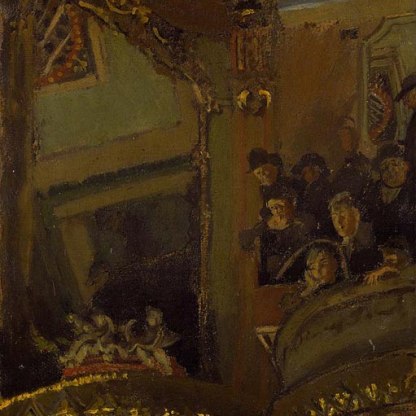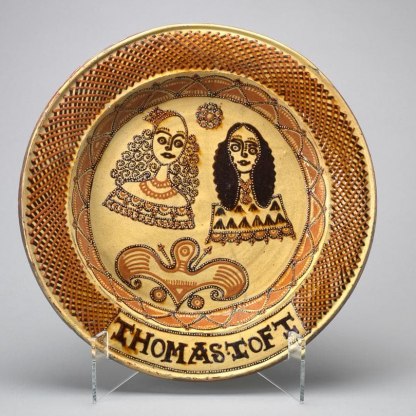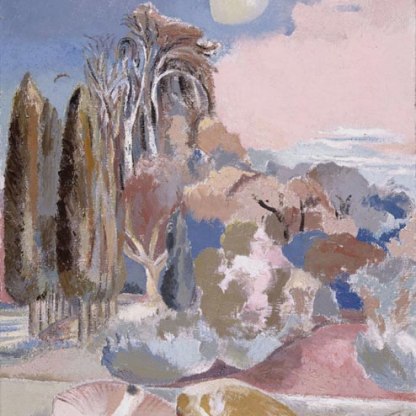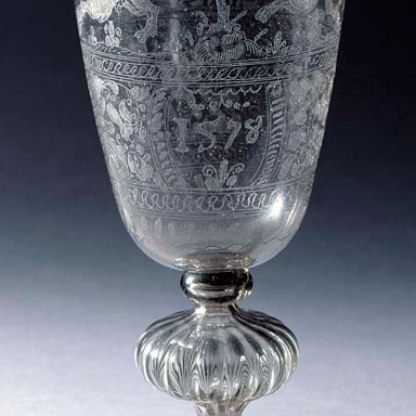The Old Bedford

Women, who have families and go to Church, roar with laughter and turn pink and hide their convulsed faces with their hands. There is nothing like Marie Lloyd, she's London if you like – she's baked potatoes and barrel organs and fish and chips – I turn round for an instant to look at the house and see rows of pink faces like shells set in coral.
Dion Clayton Calthorp, Music Hall Nights, 1925
The 'Old Bedford' referred to in the title of this painting by the German-born artist Walter Sickert, was a popular London music hall. It was situated on the High Street of Camden Town, which at the end of the nineteenth century was a densely populated, working-class area of North London.
Several versions of the same scene exist, and the picture seems to have had a number of alternative titles. One of these, Cupid in the Gallery, was perhaps a reference to the decorative plasterwork in front of the large mirror.
It has also been called The Boy I Love is up in the Gallery, the title of a song made popular by Marie Lloyd (1870–1922), the brassy music-hall performer eulogised in the quotation above, who had first performed at the Old Bedford when she was fifteen years old. Perhaps we are to imagine that the young man in the front row, his head in his hand, is gazing down and fantasising about this buxom Victorian sex symbol.
Sickert himself had once been an actor, and clearly had an enthusiasm for the music hall. It provided him with subjects for several early paintings, though there were many critics who thought such material inappropriate for a serious artist. In 1888 the first work that Sickert exhibited at the New English Art Club was a four-foot high portrait of the performer Katie Lawrence, who first popularised the song 'Daisy, Daisy, Give me Your Answer, Do'. The Old Bedford, however, is the first music-hall painting in which the artist concentrated solely on the audience.
The viewers themselves become the spectacle here. The auditorium of the Old Bedford accommodated over a thousand people seated on three tiers, so we see only a tiny fraction of those present. Although Sickert does not depict them in any great detail, there are suggestions of character: the young boy doting at the front of the balcony; the fat, rather unhappy-looking man in the bowler hat two rows behind him.
In fact, the overall tone of the painting is as subdued as he. Sickert's theatre-goers have little of the uncontrolled mirth of those described by Dion Calthorp above. Their faces are certainly not pink. This house is suffused with downbeat greens and browns that the mirrors and gilding do little to brighten. The spectators, most of them hatted, wear a uniform black. Their complexions are pale and unhealthy.
The drabness of the people contrasts with the slightly pretentious grandeur of the interior decoration – the moulded garlands, the large gilt mirror, the plaster Cupids, the ceiling grill. Like Edgar Degas, his teacher in Paris, Sickert presents working-class urban life with humanity but without sentimentality. The Old Bedford compares with the French artist's Au Cafe, in the Fitzwilliam [2387]. Like Degas, Sickert observes his subjects closely, while remaining himself unobserved. A number of preparatory drawings for The Old Bedford seem to have been actually sketched in the theatre during a performance.
In 1911 Sickert established a society of sixteen painters who exhibited their work under the collective title 'The Camden Town Group', and in 1905 he himself took lodgings at 6 Mornington Crescent, just around the corner from the New Bedford, built on the ruins of the Old when it had burned down in 1899. A nude from 1907 in the Fitzwilliam, below, was painted in his Mornington Crescent room.[PD.103-1990]

Themes and periods
Data from our collections database
With the Leicester Galleries, London, 1930; E.M.B. Ingram
Legal notes
Bequeathed by Edward Maurice Berkeley Ingram, 1941
Acquisition and important dates
- Method of acquisition: Bequeathed
- Dates: 1941
Dating
Maker(s)
- Sickert, Walter Richard Painter
Materials used in production
Read more about this recordStories, Contexts and Themes
Other highlight objects you might like
Suggested Curating Cambridge products
Sign up to our emails
Be the first to hear about our news, exhibitions, events and more…






